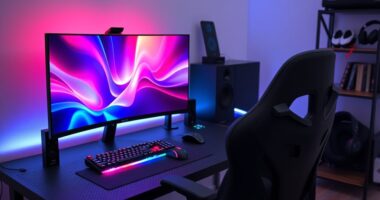To get started with VR headsets, choose the right type for your needs—tethered, standalone, or smartphone-based—and make certain your system meets the recommended specifications. Set up a safe, obstacle-free play space, adjust the headset for comfort, and calibrate sensors correctly. Start with beginner-friendly titles like Beat Saber or The Rec Room. Remember to take regular breaks and maintain your equipment. Keep exploring to learn more about creating a smooth, immersive VR experience.
Key Takeaways
- Choose the right VR headset type (tethered, standalone, or smartphone-based) based on your budget and intended use.
- Ensure your PC or console meets the hardware and system requirements for smooth VR performance.
- Set up a safe, obstacle-free play space with proper boundary markers and adequate lighting.
- Adjust the headset straps and lenses for a comfortable fit and clear visuals.
- Follow best practices for safe VR sessions, including regular breaks, equipment maintenance, and room organization.
Understanding the Basics of VR Headsets
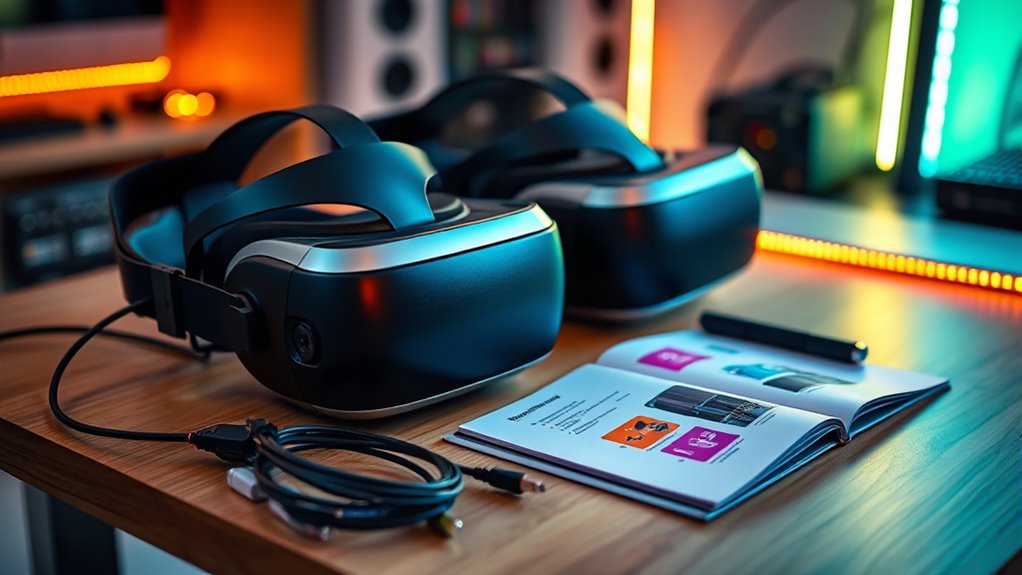
Virtual reality (VR) headsets are devices that immerse you in a digital environment by displaying 3D visuals directly in your eyes. They often include sensors that track your head movements, making the experience feel more real. Unlike augmented reality, which overlays digital images onto the real world, VR creates a fully virtual space. This technology is increasingly used for virtual collaboration, allowing remote teams to meet and work together as if they were in the same room. Understanding these basics helps you grasp how VR headsets transform digital interaction, making experiences more engaging and productive. Additionally, advancements in display technology ensure sharper images and more comfortable wear during extended use. The integration of sensor technology further enhances the realism by accurately tracking user movements and gestures. Incorporating motion tracking is essential for creating seamless and immersive VR experiences, and developing a demo reel can also showcase your familiarity with VR environments to potential clients or employers.
Types of Virtual Reality Devices
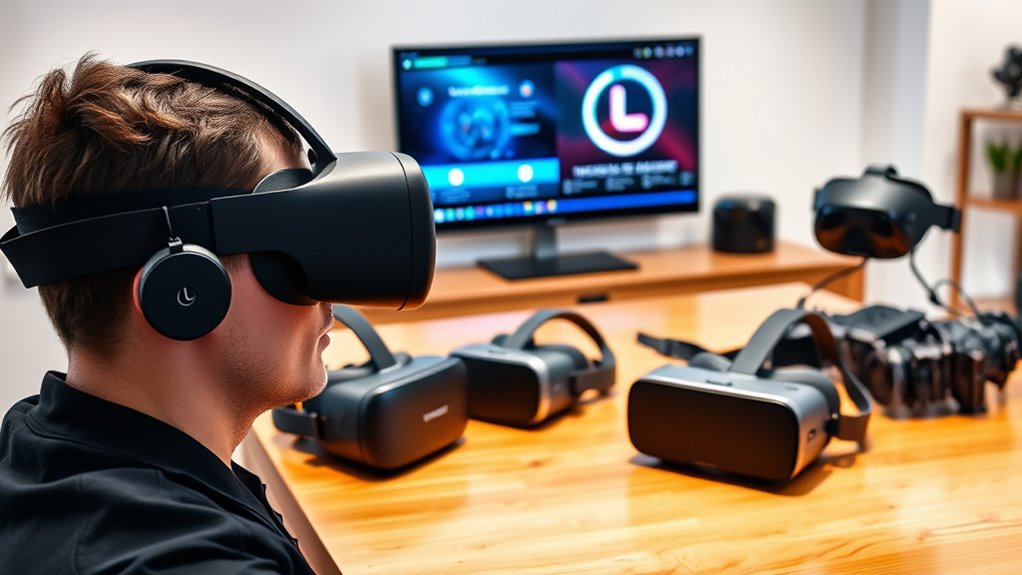
There are several types of VR devices designed to suit different needs and setups. The most common are tethered headsets, which connect to a PC or gaming console, offering high-quality visuals and immersive experiences. Standalone VR headsets operate independently, providing portability without sacrificing performance, making them ideal for casual users. Smartphone-based VR devices use your phone as the display, making them budget-friendly options. Additionally, some headsets include virtual reality accessories like motion controllers, sensors, and haptic feedback to enhance immersion. Augmented reality integration is also becoming more prevalent, blending virtual elements with the real world for applications beyond gaming, such as training or design. Choosing the right device depends on your goals, budget, and setup requirements. Advanced VR headsets often incorporate Vetted – Flat Iron Bike technology for improved comfort and performance in extended use.
Key Features to Consider When Choosing a VR Headset
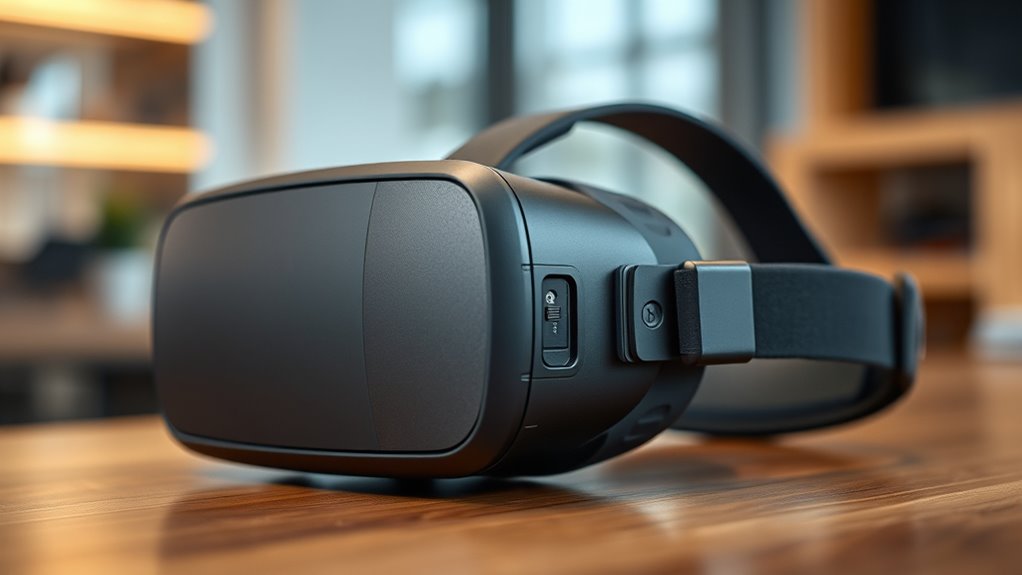
When choosing a VR headset, you should pay close attention to display resolution quality to guarantee sharp, clear visuals. Comfort and fit are also vital, as you’ll be wearing it for extended periods, so it needs to feel secure without causing discomfort. Balancing these features can notably enhance your overall virtual experience. Additionally, understanding AI detection methods can help you select devices that incorporate the latest innovations for improved performance and safety.
Display Resolution Quality
Have you pondered how display resolution impacts your overall VR experience? Higher resolution improves display clarity and pixel density, making virtual worlds feel more realistic and immersive. When choosing a headset, look for sharp visuals that reduce screen door effects and pixelation. A better display enhances your ability to focus and enjoy detailed environments without distraction.
Key features to contemplate include:
- Crisp, lifelike visuals that boost immersion
- Reduced eye strain through clearer images
- Enhanced detail for gaming and virtual exploration
- Seamless visuals that improve reaction times
- Overall satisfaction from a more realistic experience
Prioritizing display resolution quality ensures you’ll enjoy vivid, stunning visuals that truly bring your virtual adventures to life. Don’t settle for lower pixel density—your eyes will thank you.
Comfort and Fit
Choosing a comfortable and well-fitting VR headset is vital for an enjoyable experience, as prolonged use can lead to discomfort or fatigue if the headset isn’t properly suited to your head. Look for an ergonomic design that molds comfortably to your face and reduces pressure points. Adjustable straps are essential for customizing the fit, guaranteeing the headset stays secure without causing discomfort. Consider the weight distribution; a balanced design prevents neck strain. Here’s a quick comparison:
| Feature | Why it matters |
|---|---|
| Ergonomic design | Ensures comfort over long sessions |
| Adjustable straps | Customizes fit for different head sizes |
| Weight distribution | Reduces fatigue and neck strain |
| Padding | Adds comfort and prevents chafing |
Prioritize these features to enhance your VR experience. Additionally, selecting a headset with proper weight distribution can significantly improve comfort during extended use. Maintaining a comfortable fit is also essential to prevent adjustments that may interrupt your immersion. Moreover, choosing a headset with adjustable straps allows for better customization to your unique head shape, enhancing overall comfort. Incorporating features like foam padding can further improve comfort and reduce pressure during prolonged periods of use.
Compatibility and System Requirements

Before choosing a VR headset, you need to check its hardware compatibility and system requirements. Make sure your PC or console meets the hardware performance needs and supports the required operating systems. Understanding these points guarantees smooth setup and a suitable virtual reality experience. Additionally, reviewing system compatibility ensures your device can handle the demanding graphics and processing requirements of modern VR technology. It’s also helpful to consider father-daughter bond and how shared experiences might influence your setup preferences. Being aware of ongoing AI security developments can help you stay informed about potential vulnerabilities in your VR systems and ensure safe usage. Moreover, assessing existential themes related to immersive experiences can enrich your understanding of how VR influences personal perceptions.
Hardware Compatibility Checklist
Ensuring your hardware meets the necessary requirements is essential for a smooth VR experience. If your system isn’t compatible, you might face motion sickness or struggle with social interaction in multiplayer games. Check that your PC has a powerful graphics card, enough RAM, and a compatible USB port. Your headset should fit comfortably and be properly calibrated to avoid discomfort. Confirm that your sensors or cameras are correctly positioned for accurate tracking. These factors directly impact immersion and prevent frustration. Additionally, generative AI is increasingly being integrated into VR platforms to create dynamic and personalized content, enriching the user experience. Verifying hardware compatibility ensures seamless performance and helps you avoid technical issues during use. A thorough understanding of your system’s system requirements can help optimize your setup and enhance overall VR engagement. Moreover, paying attention to wall organization can help keep your play space clear and safe, facilitating better movement and reducing accidents during active gameplay.
Supported Operating Systems
Your VR headset’s performance heavily depends on your computer’s operating system, as not all systems support the latest VR software and drivers. To enjoy the full range of VR content, guarantee your OS is compatible—Windows 10 or newer is typically required, though some headsets support macOS or specific Linux versions. Check the manufacturer’s recommendations before installation. Compatibility affects not just software, but also headset accessories, like sensors and controllers, which may require specific drivers. Outdated or unsupported OS versions can lead to connectivity issues or reduced performance. Keep your system updated to ensure smooth operation. Additionally, AI in Education innovations are increasingly influencing the development of smarter, adaptive VR applications that enhance learning experiences. By confirming your OS supports your VR headset, you’ll experience seamless gameplay and avoid frustrating setup problems, making your VR adventures more immersive and enjoyable.
Hardware Performance Needs
Have you checked if your PC meets the hardware requirements for your VR headset? Ensuring your system can handle the demands is vital for an immersive experience. If your PC falls short, hardware upgrades might be necessary to meet performance benchmarks. Don’t settle for lag or stuttering—these issues can ruin your VR adventures. Upgrading components like graphics cards can significantly improve visual quality and responsiveness, making gameplay smoother. Additionally, considering hardware compatibility ensures that all your components work seamlessly together, preventing potential issues. Key considerations include: – Upgrading graphics cards for smoother visuals – Increasing RAM to support demanding applications – Updating drivers for maximum compatibility – Improving CPU performance for seamless processing – Ensuring your system’s ports and connectivity are compatible – Considering Kia Tuning options to optimize your PC’s performance for demanding tasks. Regularly checking for software updates can also enhance stability and performance. Meeting or exceeding the recommended specs guarantees a more enjoyable, frustration-free VR experience. Take the time to evaluate and upgrade where needed—your immersion depends on it.
Setting Up Your VR Space
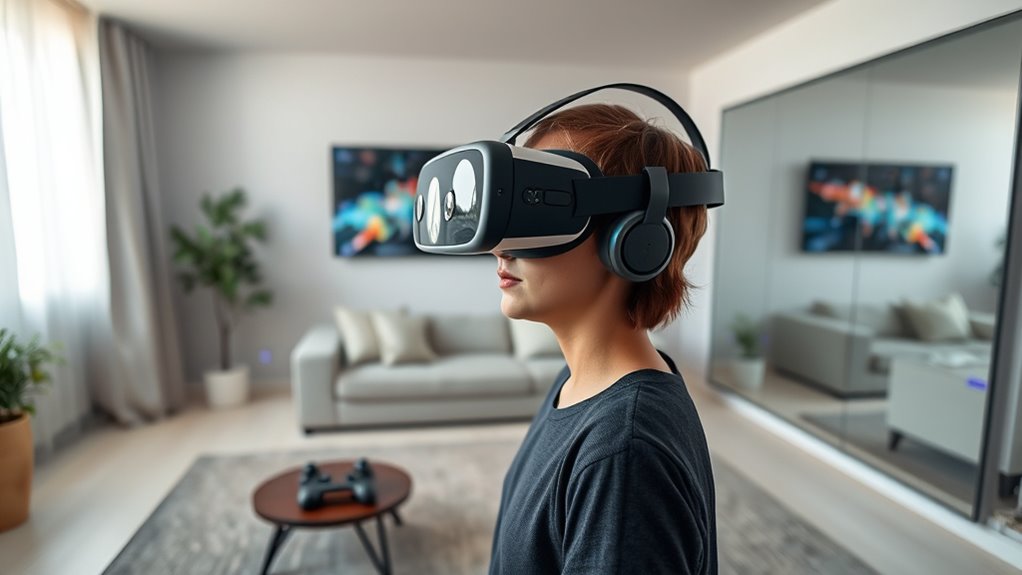
Are you ready to create a safe and comfortable space for your VR adventures? Start by clearing a dedicated area free of obstacles, guaranteeing you won’t bump into furniture or walls. Use sensor markers or boundary systems to define your play zone, and enable alerts if you get too close to the edges. For immersive experiences, take advantage of haptic feedback accessories that enhance realism without cluttering your space. Wireless connectivity simplifies setup, allowing you to move freely without tangled cables. Make sure your VR headset is within range of your Wi-Fi or Bluetooth devices for smooth tracking and data transfer. Keep the space ventilated and well-lit, and ensure your play area remains clutter-free for safe and enjoyable VR sessions. Additionally, consider security zone info to help you understand how to protect your setup and personal space during your VR activities. Understanding family dynamics can also help you optimize your space for a shared environment that respects everyone’s comfort and privacy. Being aware of potential pitfalls in adopting new technologies can help you avoid common setup challenges and security vulnerabilities. Incorporating acne patches in your skincare routine can also help maintain your skin health even during long gaming or VR sessions, especially if you experience irritation or breakouts from prolonged mask wear or stress.
How to Properly Fit and Wear Your Headset
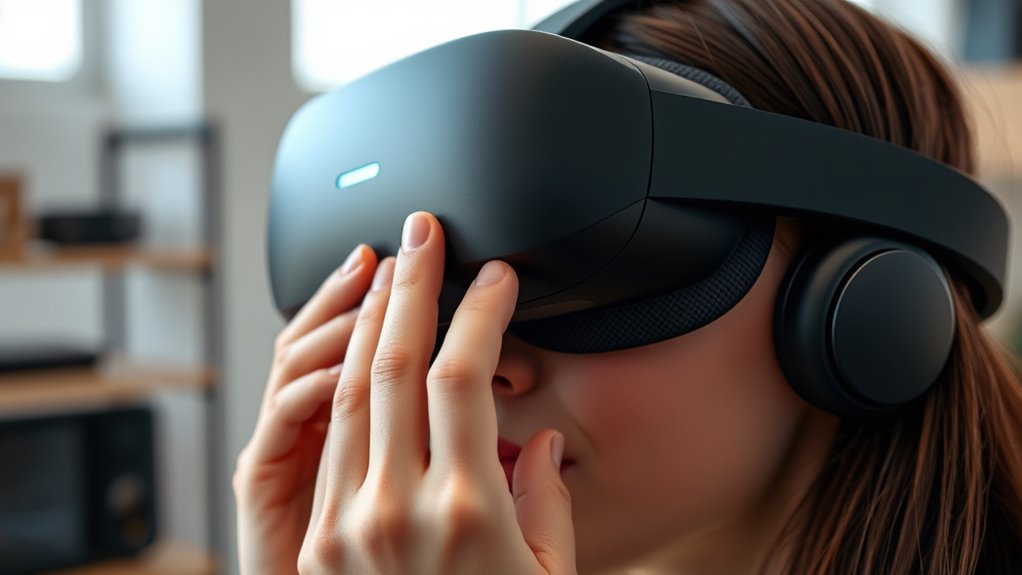
Ensuring your VR headset fits correctly is essential for comfort and ideal performance. An ergonomic design helps distribute weight evenly, reducing strain during extended use. Adjust the straps so the headset sits snugly but not too tight, preventing discomfort and maintaining headset hygiene. Clean the facial padding before each session to avoid skin irritation and germs. Make sure the lenses are aligned with your eyes for a clear view, avoiding eye strain. Keep cables and accessories organized to prevent accidental pulls. Remember, a well-fitted headset enhances immersion and minimizes fatigue.
A well-fitted VR headset ensures comfort, clear visuals, and a hygienic, immersive experience.
- Feel confident knowing you’re protecting your skin and device.
- Experience seamless comfort that keeps you engaged.
- Maintain hygiene to enjoy every session safely.
- Achieve perfect clarity with proper alignment.
- Feel empowered to maximize your VR experience.
Navigating the VR Interface and Controls

You’ll need to get comfortable with the movement gestures that move you through the virtual environment. Adjusting your control settings can make interactions smoother and more personalized. Once you master these basics, navigating your VR headset becomes quicker and more intuitive.
Mastering Navigation Gestures
Mastering navigation gestures is essential for seamlessly interacting with your VR interface and controls. Proper gesture calibration ensures your movements are recognized accurately, creating a smooth experience. With advanced hand tracking, you can perform intuitive gestures like pointing, grabbing, or swiping, making navigation feel natural. To get comfortable, practice key gestures regularly, so your system adapts quickly. When done correctly, these gestures elevate immersion, making your virtual environment feel more real. Remember, consistent gesture calibration enhances responsiveness, reducing frustration. As you become more confident, you’ll navigate effortlessly, release the full potential of your VR headset. Embrace the learning curve—mastering these gestures transforms your virtual interactions from clunky to fluid. Plunge into the process, practice often, and enjoy the intuitive control that hand tracking offers.
Customizing Control Settings
Customizing control settings allows you to tailor your VR experience to suit your preferences and improve ease of use. You can adjust controls to make navigation smoother and activate voice commands for hands-free operation, enhancing immersion. For multiplayer experiences, customizing controls helps you interact more efficiently with others and access features quickly. Many headsets let you remap buttons or set shortcuts, so you can streamline common actions. Activating voice commands lets you control menus or communicate without removing your headset or using controllers. Take time to explore these options in your settings menu, ensuring your controls feel natural. By personalizing your control setup, you’ll enjoy more intuitive interactions and a more engaging VR experience overall.
Popular VR Titles and Experiences for Beginners
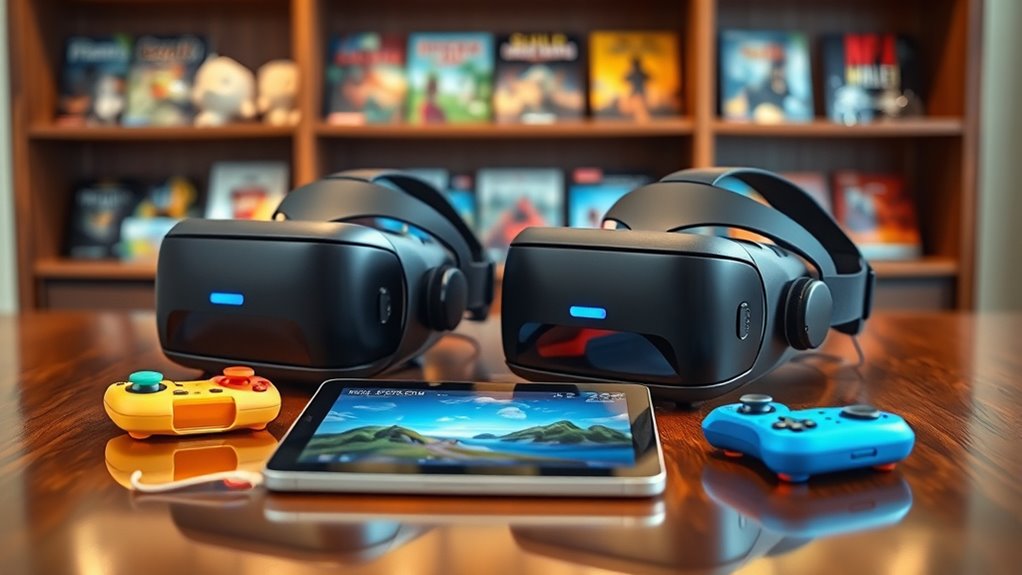
For newcomers to VR, choosing the right titles can make the experience both exciting and accessible. Exploring popular VR titles across various VR game genres helps you find immersive experiences that suit your interests. Start with titles that are easy to pick up and offer a gentle introduction to VR’s potential. These experiences can evoke wonder, excitement, and curiosity, making your first steps in VR memorable.
- Feel the thrill of flying or racing in accessible games like Beat Saberor *Superhot VR*
- Discover breathtaking worlds in titles like The Rec Roomor *Vader Immortal*
- Experience immersive storytelling with The Walking Dead: Saints & Sinners
- Engage in fun multiplayer adventures with friends
- Feel a sense of achievement with beginner-friendly puzzle and exploration titles
Tips for Safe and Comfortable VR Use
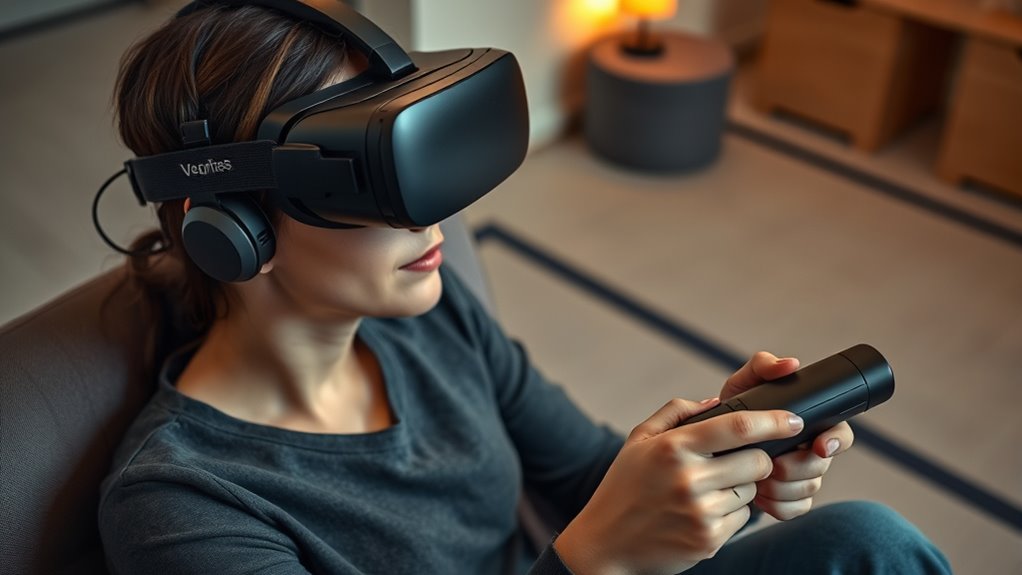
Using VR safely and comfortably is crucial to guarantee a positive experience and prevent discomfort or injury. To protect your user safety and reduce eye strain, take regular breaks—at least 10-15 minutes every hour. Adjust the head straps properly so the headset fits snugly without pressure. Keep your play area clear to avoid accidents, and ensure good lighting in your room.
| Tip | Why it helps | Best practice |
|---|---|---|
| Take breaks | Prevents eye strain | Use a timer to remind you |
| Proper fit | Avoid discomfort | Adjust straps for comfort |
| Clear space | Prevents injuries | Remove obstacles before use |
Following these tips ensures safe, comfortable, and enjoyable VR sessions.
Maintaining and Caring for Your VR Equipment
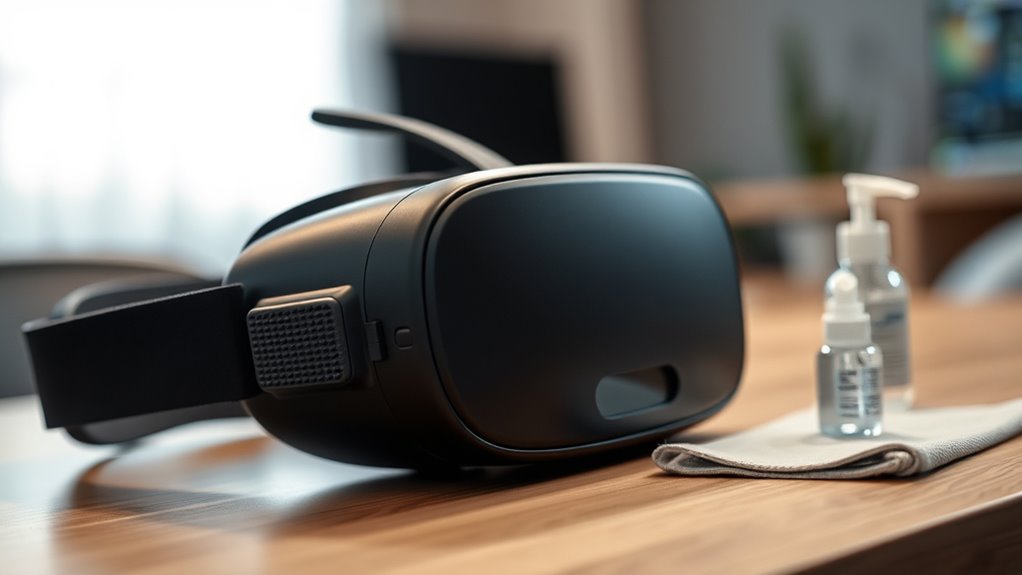
Proper maintenance and care extend the lifespan of your VR headset and guarantee ideal performance. Regular cleaning and proper storage solutions keep your device in top shape and assure a smooth experience. Handle your equipment gently, wiping lenses with a microfiber cloth and avoiding harsh chemicals. Store your headset in a cool, dry place to prevent damage from dust or moisture. Use designated storage solutions to keep cables organized and protected. Stay vigilant about cleaning and maintenance to prevent buildup of dirt and oils that can impair visuals or comfort.
- Protect your investment with thoughtful storage solutions
- Keep lenses pristine with gentle cleaning
- Avoid accidental damage by handling carefully
- Maintain comfort by replacing worn straps
- Extend device lifespan through regular upkeep
Frequently Asked Questions
How Long Should I Wear a VR Headset in One Session?
You should limit your VR headset sessions to about 30 to 60 minutes to minimize eye strain and discomfort. Pay attention to how your eyes feel; if you experience fatigue, headaches, or dizziness, take a break. It’s important to listen to your body and step away for a few minutes every half hour. Proper breaks help reduce eye strain and improve your overall VR experience.
Can I Use a VR Headset With Prescription Glasses?
If you wear prescription glasses, you’ll want to check VR headset compatibility and explore VR eyewear solutions. Many headsets are designed with spacious designs or adjustable head straps, making it possible to wear glasses comfortably. Some headsets even offer prescription lens inserts. So, you can enjoy immersive experiences without sacrificing your sight, just by choosing the right VR gear that suits your prescription needs.
What Are Common Troubleshooting Steps for VR Connectivity Issues?
When troubleshooting VR connectivity issues, start by checking your wireless connectivity to guarantee a stable signal. Restart your VR headset and the device it’s connected to, like a PC or console. Make sure your hardware compatibility is up to date, including firmware and drivers. If problems persist, re-pair your headset, test with different USB or HDMI ports, and verify your network settings. These steps usually resolve common connectivity issues quickly.
How Do I Update the Firmware on My VR Device?
Think of updating your VR device’s firmware as giving it a tune-up like a well-oiled machine. To do this, connect your headset to your PC or smartphone, then open the official app or software. Check for firmware updates, ensuring your device compatibility, and follow prompts to install the latest firmware. This process keeps your VR headset running smoothly, fixing bugs and enhancing features for a better immersive experience.
Are There Any Age Restrictions for VR Headset Users?
You should know that there are age restrictions for VR headset users to guarantee child safety. Most manufacturers recommend their devices for users aged 12 or older, emphasizing the importance of parental guidance for younger children. This helps prevent potential health issues and ensures proper use. Always check the specific headset’s guidelines and supervise children during VR sessions to promote safe and enjoyable experiences for everyone.
Conclusion
Now that you know the essentials, you’re ready to immerse yourself in the world of VR. But remember, the real adventure begins once you put on that headset and step into a new universe. Are you prepared for the incredible experiences awaiting you—and the surprises they might hold? Keep exploring, stay curious, and your virtual journey is just beginning. The question is: are you ready to see what’s beyond the screen?



